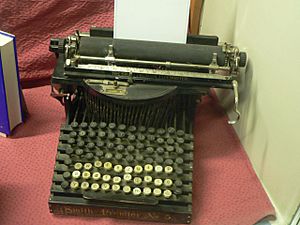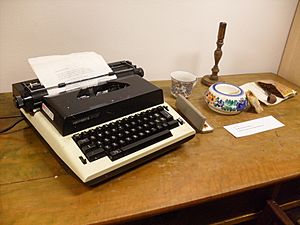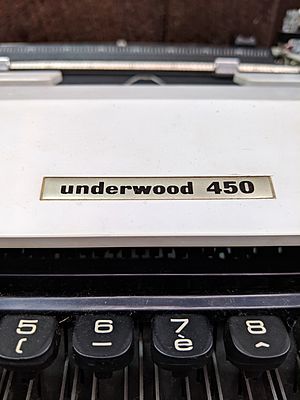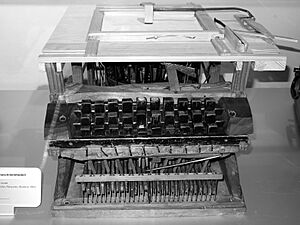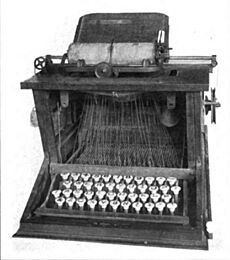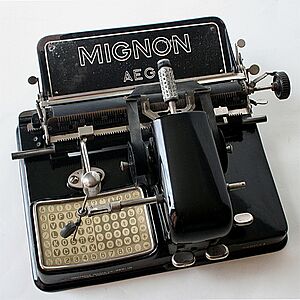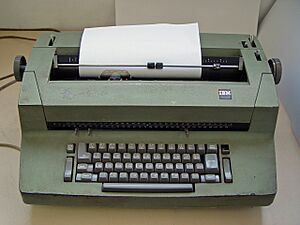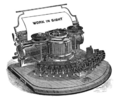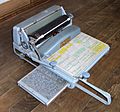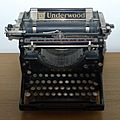Typewriter facts for kids
A typewriter is a mechanical or electromechanical machine for typing characters. Typically, a typewriter has an array of keys, and each one causes a different single character to be produced on paper by striking an inked ribbon selectively against the paper with a type element. Thereby, the machine produces a legible written document composed of ink and paper. By the end of the 19th century, a person who used such a device was also referred to as a typewriter.
A typewriter does not have computer memory. As with writing with a pen, it is difficult to correct mistakes. One advantage is that many of them are not electrical, so you do not need to plug them in. Hackers cannot see what you have typed. On many typewriters, a separate type element (called a typebar) corresponds to each key. The first commercial typewriters were introduced in 1874. They did not become common in offices until after the mid-1880s.
Typewriters quickly became a necessary tool for almost all writing other than personal handwritten letters. They were used a lot by professional writers, in offices, and for business correspondence in private homes. Typewriters were common in most offices up to the 1980s. After that, computers often replaced them. Nevertheless, typewriters are still common in some parts of the world. They are needed for a few specific applications, and they are popular in certain subcultures. Early typewriters, and later cheap ones, were "manual" typewriters. This means they were powered completely by the user. After the mid-20th century, electric typewriters with a motor became most common.
Contents
History
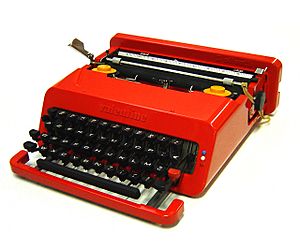
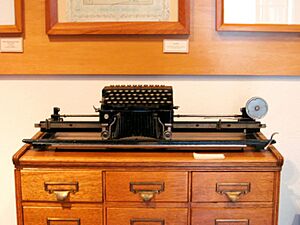
Although many modern typewriters have one of several similar designs, their invention was incremental, developed by numerous inventors working independently or in competition with each other over a series of decades. As with the automobile, the telephone, and telegraph, several people contributed insights and inventions that eventually resulted in ever more commercially successful instruments. Historians have estimated that some form of the typewriter was invented 52 times as thinkers and tinkerers tried to come up with a workable design.
Some early typing instruments include:
- In 1575, an Italian printmaker, Francesco Rampazetto, invented the scrittura tattile, a machine to impress letters in papers.
- In 1714, Henry Mill obtained a patent in Britain for a machine that, from the patent, appears to have been similar to a typewriter. The patent shows that this machine was created: "[he] hath by his great study and paines & expence invented and brought to perfection an artificial machine or method for impressing or transcribing of letters, one after another, as in writing, whereby all writing whatsoever may be engrossed in paper or parchment so neat and exact as not to be distinguished from print; that the said machine or method may be of great use in settlements and public records, the impression being deeper and more lasting than any other writing, and not to be erased or counterfeited without manifest discovery."
- In 1802, Italian Agostino Fantoni developed a particular typewriter to enable his blind sister to write.
- Between 1801 and 1808, Italian Pellegrino Turri invented a typewriter for his blind friend Countess Carolina Fantoni da Fivizzano.
- In 1823, Italian Pietro Conti da Cilavegna invented a new model of the typewriter, the tachigrafo, also known as tachitipo.
- In 1829, American William Austin Burt patented a machine called the "Typographer" which, in common with many other early machines, is listed as the "first typewriter". The London Science Museum describes it merely as "the first writing mechanism whose invention was documented", but even that claim may be excessive since Turri's invention pre-dates it.
By the mid-19th century, the increasing pace of business communication had created a need to mechanize the writing process. Stenographers and telegraphers could take down information at rates up to 130 words per minute, whereas a writer with a pen was limited to a maximum of 30 words per minute (the 1853 speed record).
From 1829 to 1870, many printing or typing machines were patented by inventors in Europe and America, but none went into commercial production.
- American Charles Thurber developed multiple patents, of which his first in 1843 was created as an aid to blind people, such as the 1845 Chirographer.
- In 1855, the Italian Giuseppe Ravizza created a prototype typewriter called Cembalo scrivano o macchina da scrivere a tasti ("Scribe harpsichord, or machine for writing with keys"). It was an advanced machine that let the user see the writing as it was typed.
- In 1861, Father Francisco João de Azevedo, a Brazilian priest, made his typewriter with basic materials and tools, such as wood and knives. In that same year, the Brazilian emperor D. Pedro II, presented a gold medal to Father Azevedo for this invention. Many Brazilian people, as well as the Brazilian federal government recognize Fr. Azevedo as the inventor of the typewriter, a claim that has been the subject of some controversy.
- In 1865, John Pratt, of Centre, Alabama (US), built a machine called the Pterotype which appeared in an 1867 Scientific American article and inspired other inventors.
- Between 1864 and 1867, Peter Mitterhofer, a carpenter from South Tyrol (then part of Austria) developed several models and a fully functioning prototype typewriter in 1867.
Hansen Writing Ball
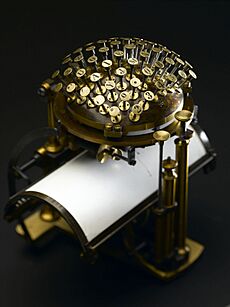
In 1865, Rev. Rasmus Malling-Hansen of Denmark invented the Hansen Writing Ball, which went into commercial production in 1870 and was the first commercially sold typewriter. It was a success in Europe and was reported as being used in offices on the European continent as late as 1909.
Malling-Hansen used a solenoid escapement to return the carriage on some of his models, which makes him a candidate for the title of inventor of the first "electric" typewriter.
The Hansen Writing Ball was produced with only upper-case characters. The Writing Ball was a template for inventor Frank Haven Hall to create a derivative that would produce letter prints cheaper and faster.
Malling-Hansen developed his typewriter further through the 1870s and 1880s and made many improvements, but the writing head remained the same. On the first model of the writing ball from 1870, the paper was attached to a cylinder inside a wooden box. In 1874, the cylinder was replaced by a carriage, moving beneath the writing head. Then, in 1875, the well-known "tall model" was patented, which was the first of the writing balls that worked without electricity. Malling-Hansen attended the world exhibitions in Vienna in 1873 and Paris in 1878 and he received the first-prize for his invention at both exhibitions.
Sholes and Glidden typewriter
The first typewriter to be commercially successful was patented in 1868 by Americans Christopher Latham Sholes, Frank Haven Hall, Carlos Glidden and Samuel W. Soule in Milwaukee, Wisconsin, although Sholes soon disowned the machine and refused to use or even recommend it. The working prototype was made by clock-maker and machinist Matthias Schwalbach. Hall, Glidden and Soule sold their shares in the patent (US 79,265) to Sholes and James Densmore, who made an agreement with E. Remington and Sons (then famous as a manufacturer of sewing machines) to commercialize the machine as the Sholes and Glidden Type-Writer. This was the origin of the term typewriter.
Remington began production of its first typewriter on March 1, 1873, in Ilion, New York. It had a QWERTY keyboard layout, which, because of the machine's success, was slowly adopted by other typewriter manufacturers. As with most other early typewriters, because the typebars strike upwards, the typist could not see the characters as they were typed.
Index typewriter
The index typewriter came into the market in the early 1880s. The index typewriter uses a pointer or stylus to choose a letter from an index. The pointer is mechanically linked so that the letter chosen could then be printed, most often by the activation of a lever.
The index typewriter was briefly popular in niche markets. Although they were slower than keyboard type machines, they were mechanically simpler and lighter. They were therefore marketed as being suitable for travellers and, because they could be produced more cheaply than keyboard machines, as budget machines for users who needed to produce small quantities of typed correspondence. For example, the Simplex Typewriter Company made index typewriters for 1/40 the price of a Remington typewriter.
The index typewriter's niche appeal however soon disappeared as, on the one hand new keyboard typewriters became lighter and more portable, and on the other refurbished second-hand machines began to become available. The last widely available western index machine was the Mignon typewriter produced by AEG which was produced until 1934. Considered one of the very best of the index typewriters, part of the Mignon's popularity was that it featured interchangeable indexes as well as type, fonts and character sets. This is something very few keyboard machines were capable of--and only at considerable added cost.
Although they were pushed out of the market in most of the world by keyboard machines, successful Japanese and Chinese typewriters typewriters are of the index type--albeit with a very much larger index and number of type elements.
Embossing tape label makers are the most common index typewriters today, and perhaps the most common typewriters of any kind still being manufactured.
The platen was mounted on a carriage that moved horizontally to the left, automatically advancing the typing position, after each character was typed. The carriage-return lever at the far left was then pressed to the right to return the carriage to its starting position and rotating the platen to advance the paper vertically. A small bell was struck a few characters before the right hand margin was reached to warn the operator to complete the word and then use the carriage-return lever.
Other typewriters
- 1884 – Hammond "Ideal" typewriter with case, by Hammond Typewriter Company Limited, United States. Despite an unusual, curved keyboard (see picture in citation), the Hammond became popular because of its superior print quality and changeable typeface. Invented by James Hammond of Boston, Massachusetts in 1880, and commercially released in 1884. The type is carried on a pair of interchangeable rotating sectors, one controlled by each half of the keyboard. A small hammer pushes the paper against the ribbon and type sector to print each character. The mechanism was later adapted to give a straight QWERTY keyboard and proportional spacing.
- 1888 – Fitch typewriter – Made by the Fitch Typewriter Company, Brooklyn, N.Y. and later in the UK with a slightly different look. Operators of the early typewriters had to work "blind": the typed text emerged only after several lines had been completed or the carriage was lifted to look underneath at the page. The Fitch was one of the first machines to allow prompt correction of mistakes with its visible writing; it was said to be the second machine operating on the visible writing system. The typebars were positioned behind the paper and the writing area faced upwards so that the result could be seen instantly. A curved frame kept the emerging paper from obscuring the keyboard, but the Fitch was soon eclipsed by machines in which the paper could be fed more conveniently at the rear.
- 1893 – Gardner typewriter. This typewriter, patented by Mr J Gardner in 1893, was an attempt to reduce the size and cost. Although it prints 84 symbols, it has only 14 keys and two change-case keys. Several characters are indicated on each key and the character printed is determined by the position of the case keys, which choose one of six cases.
- 1896 – The "Underwood 1 typewriter, 10" Pica, No. 990". This was the first typewriter with a typing area fully visible to the typist until a key is struck. These features, copied by all subsequent typewriters, allowed the typist to see and if necessary correct the typing as it proceeded. The mechanism was developed in the US by Franz X. Wagner from about 1892 and taken up, in 1895, by John T. Underwood (1857–1937), a producer of office supplies.
Standardization
By about 1910, the "manual" or "mechanical" typewriter had reached a somewhat standardized design. There were minor variations from one manufacturer to another, but most typewriters followed the concept that each key was attached to a typebar that had the corresponding letter molded, in reverse, into its striking head. When a key was struck briskly and firmly, the typebar hit a ribbon (usually made of inked fabric), making a printed mark on the paper wrapped around a cylindrical platen.
The platen was mounted on a carriage that moved horizontally to the left, automatically advancing the typing position, after each character was typed. The carriage-return lever at the far left was then pressed to the right to return the carriage to its starting position and rotating the platen to advance the paper vertically. A small bell was struck a few characters before the right hand margin was reached to warn the operator to complete the word and then use the carriage-return lever. Typewriters for languages written right-to-left operate in the opposite direction.
By 1900, notable typewriter manufacturers included E. Remington and Sons, IBM, Godrej, Imperial Typewriter Company, Oliver Typewriter Company, Olivetti, Royal Typewriter Company, Smith Corona, Underwood Typewriter Company, Facit, Adler, and Olympia-Werke.
After the market had matured under the market dominance of large companies from Britain, Europe and the United States—but before the advent of daisywheel and electronic machines—the typewriter market faced strong competition from less expensive typewriters from Asia, including Brother Industries and Silver Seiko Ltd. of Japan.
Frontstriking
In most of the early typewriters, the typebars struck upward against the paper, pressed against the bottom of the platen, so the typist could not see the text as it was typed. What was typed was not visible until a carriage return caused it to scroll into view.
The difficulty with any other arrangement was ensuring the typebars fell back into place reliably when the key was released. This was eventually achieved with various ingenious mechanical designs and so-called "visible typewriters" which used frontstriking, in which the typebars struck forward against the front side of the platen, became standard. One of the first was the Daugherty Visible, introduced in 1893, which also introduced the four-bank keyboard that became standard, although the Underwood which came out two years later was the first major typewriter with these features.
Shift key

A significant innovation was the shift key, introduced with the Remington No. 2 in 1878. This key physically "shifted" either the basket of typebars, in which case the typewriter is described as "basket shift", or the paper-holding carriage, in which case the typewriter is described as "carriage shift". Either mechanism caused a different portion of the typebar to come in contact with the ribbon/platen.
The result is that each typebar could type two different characters, cutting the number of keys and typebars in half (and simplifying the internal mechanisms considerably). The obvious use for this was to allow letter keys to type both upper and lower case, but normally the number keys were also duplexed, allowing access to special symbols such as percent, %, and ampersand, &.
Before the shift key, typewriters had to have a separate key and typebar for upper-case letters; in essence, the typewriter had two keyboards, one above the other. With the shift key, manufacturing costs (and therefore purchase price) were greatly reduced, and typist operation was simplified; both factors contributed greatly to mass adoption of the technology.
Tab key
To facilitate typewriter use in business settings, a tab (tabulator) key was added in the late nineteenth century. Before using the key, the operator had to set mechanical "tab stops", pre-designated locations to which the carriage would advance when the tab key was pressed. This facilitated the typing of columns of numbers, freeing the operator from the need to manually position the carriage. The first models had one tab stop and one tab key; later ones allowed as many stops as desired, and sometimes had multiple tab keys, each of which moved the carriage a different number of spaces ahead of the decimal point (the tab stop), to facilitate the typing of columns with numbers of different length ($1.00, $10.00, $100.00, etc.)
"Noiseless" designs
The first typewriter to have the sliding type bars (laid out horizontally like a fan) that enable a typewriter to be "noiseless" was the American made Rapid which appeared briefly on the market in 1890. The Rapid also had the remarkable ability for the typist to have entire control of the carriage by manipulation of the keyboard alone. The two keys that achieve this are positioned at the top of the keyboard (seen in the detail image below). They are a "Lift" key that advances the paper, on the platen, to the next line and a "Return" key that causes the carriage to automatically swing back to the right, ready for one to type the new line. So an entire page could be typed without one's hands leaving the keyboard.
In the early part of the 20th century, a typewriter was marketed under the name Noiseless and advertised as "silent". It was developed by Wellington Parker Kidder and the first model was marketed by the Noiseless Typewriter Company in 1917. Noiseless portables sold well in the 1930s and 1940s, and noiseless standards continued to be manufactured until the 1960s.
In a conventional typewriter the type bar reaches the end of its travel simply by striking the ribbon and paper. The Noiseless, developed by Kidder, has a complex lever mechanism that decelerates the type bar mechanically before pressing it against the ribbon and paper in an attempt to dampen the noise.
-
Electronic typewriter – the final stage in typewriter development. A 1989 Canon Typestar 110
-
The Brother WP1, an electronic typewriter complete with a small screen and a floppy disk reader
Decline
The rise of computers in the late 20th century marked the beginning of the end for the typewriter. Computers offered many advantages over typewriters, including the ability to easily edit text, store documents electronically, and print multiple copies quickly. By the 1990s, the typewriter industry had significantly declined.
The early 21st century saw revival of interest in typewriters among certain subcultures, including makers, steampunks, hipsters, and street poets.
Interesting facts about typewriters
- The first commercial typewriters were introduced in 1874, but did not become common in offices in the United States until after the mid-1880s.
- Some electric typewriters were patented in the 19th century, but the first machine known to be produced in series is the Cahill of 1900.
- James Fields Smathers of Kansas City invented what is considered the first practical power-operated typewriter in 1914.
- The final major development of the typewriter was the electronic typewriter. Most of these replaced the typeball with a plastic or metal daisy wheel mechanism (a disk with the letters molded on the outside edge of the "petals").
- In November 2012, Brother's UK factory manufactured what it claimed to be the last typewriter ever made in the UK; the typewriter was donated to the London Science Museum.
- Jack Kerouac, a fast typist at 100 words per minute, typed his 1957 novel On the Road on a roll of paper so he would not be interrupted by having to change the paper. Within two weeks of starting to write On the Road, Kerouac had one single-spaced paragraph, 120 feet (37 m) long.
- J. R. R. Tolkien was accustomed to typing from awkward positions: "balancing his typewriter on his attic bed, because there was no room on his desk".
Gallery
-
Hansen Writing Ball, invented in 1865 (1870 model)
-
Hammond 1B, as used by a newspaper office in Saskatoon around 1910
-
typewriter robotron S 1001 from VEB Robotron-Elektronik at the GDR, this sample is owned by the MEK
-
Personal typewriter of Mozaffar ad-Din Shah Qajar, the fifth Qajar king of Persia (Iran), made in late 19th century
Related pages
See also
 In Spanish: Máquina de escribir para niños
In Spanish: Máquina de escribir para niños


